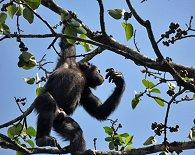Western chimpanzee
| Western chimpanzee | |
|---|---|

| |
| Scientific classification | |
| Domain: | Eukaryota |
| Kingdom: | Animalia |
| Phylum: | Chordata |
| Class: | Mammalia |
| Order: | Primates |
| Suborder: | Haplorhini |
| Infraorder: | Simiiformes |
| Family: | Hominidae |
| Subfamily: | Homininae |
| Tribe: | Hominini |
| Genus: | Pan |
| Species: | P. troglodytes |
| Subspecies: | P. t. verus
|
| Trinomial name | |
| Pan troglodytes verus Schwarz, 1934
| |

| |
The western chimpanzee or West African chimpanzee
Etymology
The taxonomical genus Pan is derived from the
Taxonomy and genetics
The western chimpanzee (P. t. verus) is a subspecies of the
Western chimpanzees are the most genetically differentiated and
Distribution and habitat
The population of the western chimpanzee once spanned from southern Senegal all the way east to the Niger River.[1][6] Today, the largest populations remaining are found in Guinea, Sierra Leone, and Liberia.[1][7]
Behavior

Diet and hunting
Male and female western chimpanzees differ in their prey. In Fongoli, Senegal,
Unique behaviors
Western chimpanzees have unique behaviors never observed in any of the other subspecies of the chimpanzee. In fact, their behaviour is so diverged from that of their fellow subspecies of chimpanzee that it has been proposed West African chimpanzees may be a distinct species in their own right.[10] They make wooden spears to hunt other primates, use caves as homes, share plant foods with each other, and travel and forage during the night. They also submerge themselves in water and play in it to stay cool in the oppressive heat.[10][11][12]
Female west African chimpanzees are quite gregarious and often support one another in conflicts with males, resulting in a more gender-balanced hierarchy than that of the rigidly patriarchal east african chimpanzees.[citation needed] Female West African chimpanzees have been observed hunting and accompany males on territorial patrols, playing a more important role in social dynamics than other chimpanzee subspecies.[13] While it was traditionally accepted that only female chimpanzees immigrate and males remain in their natal troop for life, western chimpanzees uniquely exhibit female and male immigration between groups, suggesting males are less territorial and more willing to accept unfamiliar males.[14] Paternity tests indicate males frequently mate with females from several different communities, siring infants from them. There are even cases of solitary male western chimpanzees, while in any other population, a chimpanzee couldn't survive alone.[15] Male West African chimpanzees generally are respectful of females and do not forcibly confiscate food from them,[16] which may at least partly stem from the gregarious females forming alliances.[17] Among the Tai forest community, infants are often adopted by unrelated adults, with both sexes adopting infants in equal measure.[18] Female western chimpanzees also can rebuff the unwanted advances of males and select males to breed with on their own terms. This further is in line with the active and possibly co-dominant role female western chimpanzees play in their communities.[19]
Conservation status
The IUCN lists the western chimpanzee as
References
- ^ . Retrieved 8 August 2021.
- ^ Meder, A. (1995). "Men who named the African apes". Gorilla Journal (11). Germany.
- ISBN 978-3-89823-435-1.
- PMID 21368170.
- PMID 27789843.
- ^ "Western chimpanzee - population & distribution". Panda.org. World Wide Fund for Nature. 1 June 2007. Archived from the original on 25 April 2009. Retrieved 9 March 2009.
- IUCN. Retrieved 3 November 2022.
- PMID 26064638.
- S2CID 16551874.
- ^ a b Last, C. "Are western chimpanzees a new species of Pan?". Scientific American Blog Network. Retrieved 6 October 2020.
- ^ "Almost human". National Geographic. 15 May 2012. Archived from the original on 6 March 2008. Retrieved 13 December 2012.
- ^ Fongoli chimps spearing. National Geographic.
- PMID 32537232.
- S2CID 9267686.
- S2CID 24529322.
- ^ Larson, S. "Female chimps more likely than males to hunt with tools". Smithsonian Magazine. Retrieved 5 November 2020.
- hdl:1874/285302.
- ^ Moskowitz, C. (26 January 2010). "Altruistic chimpanzees adopt orphans". livescience.com. Retrieved 24 February 2021.
- S2CID 986042.

